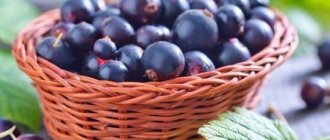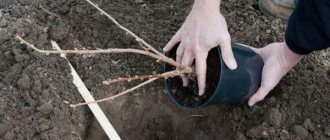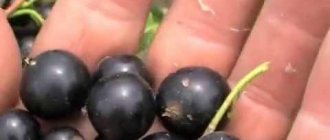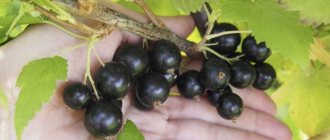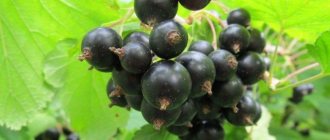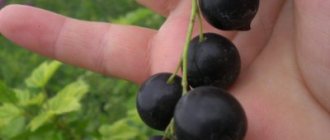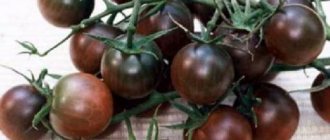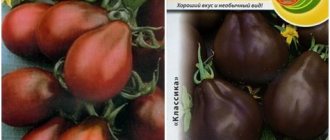Black currant Leningrad giant: description of the variety
Black currant Leningrad giant: photo of the variety
The blackcurrant variety Leningrad Giant was developed by St. Petersburg breeders E.I. Glebova and A.I. Potashova by pollinating “Stakhanovka Altai” - “Exhibition” and “Non-shattering”. The period for breeding the Leningrad giant blackcurrant should be considered the 70s of the last century. The size of the berries of this variety fully corresponds to the name - at that time they were very large. Compared to modern varieties, the fruits of the “Leningrad Giant” can be called average.
Tall currant bushes of the Leningrad Giant variety have erect shoots. With large harvests, the bush can become spreading.
The color of thick, downy annual shoots is green. The branches of more mature bushes are grayish-beige with plump egg-shaped buds, located 6-8 pieces per branch. The buds are pink-purple, slightly deviating from the branch. The Leningrad Giant variety is often distinguished by these interesting features.
The black currant variety in question has large, light green leaves. The tops have yellow-green leaves. The leaf blade is matte, bubbly-wrinkled with dark but noticeable veins. The leaves are five-lobed, with a wider and longer middle lobe and sharp tips. The lateral parts of the leaves have a triangular shape, while the lower part is asymmetrical.
The berries of this variety are formed on clusters of different sizes. One brush can have 6-13 flowers, and later - berries. In terms of fruit set, the variety has an average rating, that is, it is partly self-pollinating. Accordingly, with pollinators the yield will be much higher.
The fruits are round with black, thin, shiny skin; the weight of one berry can reach two grams. The fruits have juicy, tender pulp and a well-defined currant aroma and dessert taste. The berries do not crumble and come off perfectly.
Leningrad giant currant has excellent taste and beneficial properties. In it:
- dry matter – up to 24%;
- sugar – up to 13%;
- free acids – up to 255 mg/100 g of fruit.
Appearance, characteristics of berries, ripening time, yield
Description of the plant:
- The bush is upright, tall, about 160 cm in height. Marked by good precocity, fruiting begins in the second year of plant cultivation. When the berries ripen, the branches diverge slightly to the sides. Young shoots are thick, green, and pubescent. Mature branches are gray-beige, thick, with slight pubescence.
- The leaves are large, with five lobes, light green. The tops are green, with a yellow tint. The leaf blade is matte and wrinkled.
- The buds are pink, egg-shaped, with a blunt tip. On mature branches they form in groups of several.
- The flowers are large, light red in color. Brushes are formed of different lengths, with 6 or more berries.
- The fruits are large (up to 2.2 g). Round, color - black, with glitter. The calyx is small, the peel is thin. The pulp has a dense structure and is juicy. The taste is dessert, sweet and sour, the aroma is classic, currant. Berries with dry separation. They don't crumble. The chemical composition of the fruit depends on the climate and soil quality. Fresh berries contain (minimum): 15.3% dry matter, 7.1% sugars, 2.4% free acids, 155.2 mg/100 g ascorbic acid.
Ripening begins in the 20th of July. Productivity is high, up to 4.5 kg per plant per season
Black currant Leningrad giant: characteristics of the variety
Black currant Leningrad giant: photo of the variety
The Leningrad Giant blackcurrant variety is now becoming less and less common in Russian households, as more modern varieties are preferred. But some indicators of the “old” variety are much ahead of the “young” variety.
- About the advantages and disadvantages of the variety
Pros:
- early maturation;
- non-shattering of fruits;
- high frost resistance, therefore, the ability to grow in harsh climates;
- good yield (3-3.5 kg / 1 bush);
- industrial scale of cultivation allows achieving yields of up to 20 tons / 1 ha;
- excellent taste;
- transports well;
- the ripening of the crop occurs at the same time, which allows the use of mechanical harvesting of fruits;
- There is no terry.
Minuses:
As mentioned above, the Leningrad Giant blackcurrant variety was created in the 70s of the 20th century, and therefore, then breeders did not have the techniques of our time. Hence the shortcomings of culture.
- a variety with 50% self-fertility, so the presence of other pollinating varieties is required;
- with high yields there is a danger of broken branches due to fragility;
- sensitivity to negative temperatures in spring;
- flowers that survived spring frosts do not produce ovaries;
- predisposition to powdery mildew attack;
- average yield when compared with current varieties;
- — quite complex care with regular preventive treatments is required.
All these difficulties do not stop true connoisseurs of the variety in question. The Leningrad Giant currant variety continues to occupy its rightful place in the homesteads of Russian gardeners.
Characteristics
As already noted in the description of the Leningrad Giant variety, as well as according to reviews, currants are gradually leaving their summer cottages. Although this is the wrong decision, because according to some indicators it can give odds to new varieties.
Advantages
- Receiving early products.
- The berries do not fall off.
- Due to its high winter hardiness, the plant can be grown in harsh conditions.
- From 3 to 4.5 kg of berries are harvested from one bush. When growing berry bushes on an industrial scale, the yield reaches 20 tons per hectare of plantings. The harvest is not bad, although compared to many modern currant varieties, the Leningrad Giant loses a little.
- Good taste and transportability allow the “old man” to remain on the Russians’ property.
- Possibility of mechanical harvesting, since the berries ripen almost simultaneously.
- Terry growth on plants is practically not observed.
Disadvantages of the variety
Since the Leningrad Giant blackcurrant was created in the 80s of the last century, breeders did not have the techniques that are used today.
That is why the variety has disadvantages:
- One hundred percent fertilization is possible in the presence of pollinating bushes, since self-fertility is only slightly above 50%
- Excessive fragility of branches that can break under the weight of filling grapes.
- This variety of currants is sensitive to spring frosts. Flowers exposed to low temperatures do not set.
- The plant is sensitive to powdery mildew.
Comment! It should also be noted that growing this variety of currants is not so easy. Regular preventive treatments will be required.
But connoisseurs of the delicious Leningrad giant blackcurrant berries, as gardeners note in their reviews, are not deterred by the difficulties. They continue to plant bushes in the plots.
Black currant Leningrad giant: planting
Black currant Leningrad giant: photo of the variety
The Leningrad Giant blackcurrant variety has high soil requirements. The landing site must be sunny and windless. It is good to plant currant bushes near a fence or wall, which will provide natural protection to the plants.
Planting of seedlings is carried out in the spring, before sap flow. Also planted in the fall, before frosty days; then the currants will be able to strengthen.
It should be remembered that currants grown in the shade have little sugar and a lot of acid.
- About preparing seats
Demanding requirements to soils is the main distinguishing feature of the “Leningrad Giant” from other varieties of currants. Excellent productivity can only be achieved on nutritious soil rich in organic fertilizers. The variety in question grows poorly on poor podzolic soils and chernozems, and on highly alkaline soils.
It is worth emphasizing that any variety of currant should not be planted in a wetland, since excess moisture has a negative effect on the root system.
When planting in autumn, the holes are prepared in half a month. Approximate pit size: 0.5×0.5×0.5 m.
In the case of spring planting of currants, the preparation of holes begins in the fall.
What is the preparation?
First, prepare a drainage layer of small pebbles. The soil from the dug hole is mixed with compost or humus (6-8 kg) and superphosphate (2 tbsp) and the hole is filled.
About methods of reproduction
Common methods of propagating the Leningrad Giant blackcurrant variety are using cuttings, layering and dividing bushes. Young shoots of black currant have the ability to grow a root system.
- Propagation by cuttings . Choose a strong shoot, cut it at an angle on both sides, leaving buds on each cutting (4-5 pieces). Such cuttings can be planted directly into the soil or placed first in a glass of water. Some gardeners have an interesting way of growing currant cuttings in potatoes. That is, they make a hole in the potato where the cutting is placed. In this form, they are planted in open ground.
- Reproduction by layering. First, choose a strong branch. Tilting it and pressing it with a bracket, sprinkle it with soil. In the summer, observe, not allowing the soil to dry out. By September we can confidently say that a good root system has been formed. Such seedlings are already ready to be planted in their permanent places.
- Reproduction by dividing the bush . This is one of the most common methods of propagating black currants. They take the most overgrown bush and, digging it up, divide it into several parts. Each division should have a well-developed root system.
How to plant currants in open ground?
Also check out these articles
- When to plant eggplant seedlings in 2021
- The best potato varieties with descriptions and photos
- Raisin grapes
- Raspberry variety Golden Domes
Recommended planting near a fence or any other natural protection
Select a sunny place for planting - in the shade the berries will be sour. Recommended planting near a fence or any other natural protection. Such a fence will partially protect the bush and branches from strong winds, which are possible throughout the year.
The soil should be fertilized, but most importantly not waterlogged. If the humidity is high, the bush will not grow and will simply rot.
Planting time is early spring, before the start of sap flow, or early autumn, so that the Leningrad giant currant has time to take root before the first frost.
Only healthy seedlings are taken for planting
Only healthy seedlings are taken for planting. When examined, they should not break. Branches must be flexible. There should be no signs of disease or fungi. Any swelling on the branches is a sign of a possible pest that simply overwinters under the bark.
The planting scheme is the simplest. A hole is dug under the bush, the dimensions depend on the bush itself. For an average bush with 2-3 pagons, a hole measuring 50x50x50 cm is required. Fertile soil is prepared from the soil obtained after digging the hole. To do this, it is mixed with compost or humus.
After this, the seedling is inspected for the last time; it is important that the roots are strong, even and not broken.
A mound of fertile soil is poured into the hole, and a bush is placed on it at a slight angle. If this is difficult to do, you can install it evenly, just at an angle the plant will take root faster. After installation, it’s worth checking to see if there are any bent or tangled roots; if anything, they need to be straightened out so that they take root faster. Now you can fill the bush with soil evenly on all sides. After the procedure, the ground is trampled and watered.
Planting stages
- First, you should inspect each seedling. Seedlings must have living and flexible branches. Rejection of seedlings is carried out if signs of disease or harmful insects are detected. Such planting material will not bring any harvest over time, but will become a source of infectious diseases for other crops.
- The holes are dug about a meter from each other, the distance between the rows is 1.5-2 meters. Compliance with the specified footage will allow you to conveniently care for the bushes of the Leningrad giant.
- Just like in the classic case of planting any currant, a small hill is built in the center of the hole, where the seedling is installed. A special feature when planting any currant seedlings is the location of the young plant at an angle of 45-60°. This guarantees better survival rate.
- The roots must be carefully straightened, distributed throughout the hole and sprinkled with nutritious soil.
- The soil should be compacted a little and watered thoroughly. It is necessary to ensure that moisture penetrates to the roots. In this case, the air remaining after compacting the soil will be squeezed out by water, and the roots will easily adhere to the soil.
Berry picking and storage
The average harvest amount is 20 t/ha or 3-4.5 kg/bush
The amount of harvest depends on proper care, but the average value is 20 t/ha or 3-4.5 kg/bush. Harvest when the berries acquire a sweet and sour taste. If you leave them on the branches for too long, they simply fall off. You can collect it manually, but Leningrad giant currants are also suitable for mechanical harvesting.
The berries of the Leningrad Giant variety are suitable for fresh consumption and for processing for the winter. If you want to somehow preserve the berries for the winter, you just need to freeze them or make jam, since they will be stored in the refrigerator for no more than 15 days.
Today it is quite problematic to choose the appropriate variety of blackcurrant. This is due to the fact that it is presented in a wide range. Each of the available species differs in its ripening time, yield and growing conditions. If you want to grow currants that are unpretentious in care and at the same time give high yields, then you should pay attention to the Leningrad Giant variety.
Black currant Leningrad giant: care
Black currant Leningrad giant: photo of the variety
The Leningrad Giant blackcurrant variety is not self-pollinating; therefore, it requires pollinating neighbors. Caring for this variety typically consists of watering, loosening, weed removal, fertilizing, preventive (or therapeutic) treatments against diseases and harmful insects.
Watering in the absence of precipitation should be weekly. For one bush, 2-3 buckets of water are enough.
Along with watering, fertilizing is carried out (2 times during the growing season). At the beginning of berry ripening, the leaves of the Leningrad giant bushes are sprayed with any microfertilizer. At the beginning of spring, fertilize with liquid nitrogen fertilizers under the roots.
As stated above, this variety is sensitive to spring frosts in the spring. Even at minus 2 degrees, flowers may suffer and not bud.
Leningrad giant blackcurrant bushes are protected from dangerous spring frosts as follows:
- make abundant watering of the bushes not only at the root, but also from above throughout the entire volume of the bush (after the water freezes at night, an ice coat will “envelop” the tassels with flowers and ovaries and will maintain zero degrees, which is life-saving for the plant);
- cover the bushes with materials that maintain a positive temperature.
From reviews it became known that from a large number of berries, the branches of the Leningrad giant currant can break. For this reason, in the spring they must be tied to supports. Pegs (4 pcs/1 bush) are suitable for this. Having placed them at the same distance from each other, around the circumference of the bush, they are tied with a rope and stuffed with slats.
Features of care
According to the description of the variety, as well as reviews from gardeners, the Leningrad Giant currant requires pollinator neighbors.
As for the features of care, they come down to standard measures: watering and loosening, removing weeds and fertilizing, as well as treating against diseases and pests. If there is no precipitation, you need to water the currant bushes every week. One plant requires 2-3 buckets of water.
Simultaneously with watering, fertilizing is introduced. It is performed twice during the growing season. When the berries begin to fill, the bushes of the Leningrad Giant variety are fed leaf by leaf with any microfertilizer. At the beginning of the growing season, in early spring, nitrogen fertilizers are applied in liquid form at the root.
As noted in the description, the variety may suffer from spring frosts. Frosts of -2 degrees and below become destructive for it.
To protect flowers and ovaries, in the evening:
- Plantings are watered abundantly not only under the root, but also around the entire perimeter from above. At night the water will freeze, and under the ice coat (0 degrees inside!) the tassels with flowers and ovaries will remain alive.
- Cover the bushes with any material under which a positive temperature is maintained.
Gardeners often complain in reviews that Leningrad Giant currant branches do not withstand high yields and break. That is why in the spring the bushes must be tied to a support. You can drive in 4 pegs and tie them around the perimeter with thick twine or stuff them with slats.
Useful tips for caring for currants:
Diseases and pests
The greatest danger to the Leningrad Giant blackcurrant variety is powdery mildew. Traditional methods will not help in the fight against it, so chemicals are used for this purpose.
The first treatment with the drugs “Hom”, “Ordan” and others is carried out in early spring, before the buds open. The next spraying is done after a couple of weeks, and so on several times. Processing is completed 20 days before the expected berry harvest.
In the event of an attack of powdery mildew, fungicides are used for treatment. For this purpose, you can use Colloidal sulfur (Tiovit Jet); “Vectru”, “Topaz”, “Raek”. They treat the affected bushes twice with alternating agents. Treatment is stopped 3 weeks before harvest.
Harvesting and transportation, keeping quality of berries
Berries must be picked in dry weather. The fruits are ready for harvesting when they acquire their characteristic, sweet and sour taste. The process is carried out manually or mechanically. The fruits should be removed carefully, the entire cluster at once, along with the stalk.
Important! Watering should be stopped 2 weeks before harvest.
The berries of the Leningrad Giant tolerate transportation well. To do this, they are placed in containers that can hold 2-3 kg of fruit.
Best before date:
- fresh berries are stored in the refrigerator for about three weeks;
- frozen - 18 months;
- dried fruits - about three years;
- jams and compotes - 24 months.
Leningrad Giant is “inferior” to modern varietal representatives in terms of yield and weight of berries. But it has an incomparable taste and aroma. Some difficulties in care do not prevent gardeners from growing this variety for personal use and sale. And although the described variety is no longer in the State Register, it can still be found in the gardens of experienced summer residents.
Black currant Leningrad giant: reviews from gardeners about the variety
- Margarita Semenovna, 66 years old, Novgorod region: “I have a lot of experience working in the garden. I have had the Leningrad giant currant for a long time. About once every 15 years I move it to a new place. I wouldn't trade this variety for anything! These tasty and aromatic berries, I get up to 5 kilos per bush, a replacement for this wonderful variety still needs to be looked for among modern varieties. I make preserves, jams, compotes from them, and freeze several bags in the winter. I recommend this variety to everyone."
- Anastasia Sergeevna, 41 years old, Kaluga region: “I got the black currant Leningrad giant from my mother. Bushes with good yield - more than 4 kg of berries from 1 bush. They often write that the variety is capricious, but I disagree with this. Coming to my dacha no more than once a week, you can imagine how much time I can devote to it. Rather, it’s the other way around! What can you do? Water and feed 4 times during the summer with organic fertilizer. Most often, I use wood ash, mullein, and nettle infusion as organic matter.”
How to grow
If you use mineral compositions, then you should give preference to double superphosphate - 70-80 g, potassium sulfate or wood ash - 30-40 g. An important factor is the fight against aphids on black currants, and an understanding of the use of extermination agents.
Watering
It is necessary to moisten the soil 2-3 times a week. One bush will require about 10 liters of liquid. In case of severe drought, watering should be done 2 times a day - in the evening and in the morning.
It is important to maintain regular watering from July to August. It is at this time that fruiting occurs and flower buds are laid on the bushes, which form the future harvest
If there is not enough moisture, you can lose the harvest for several years.
To cover the plant, you should use horse humus mulch. It is placed in the area of the tree trunk circle.
Trimming
Thanks to proper pruning, you can increase the yield of the plant, increase the size of the berries and prevent the development of diseases. As soon as the young seedling goes into the hole, it must be cut by 2/3. This way he can quickly form a bush.
Pruning of shoots is carried out close to the ground. It is not recommended to leave stumps. The oldest branches that are more than 5 years old are subject to removal. Also, diseased branches should not be left. Those shoots on which the berries are located and growing close to the ground are also removed. Another important factor is information about how to treat currants against gall aphids.
Video shows how to care for bushes:
From time to time the bush will have to be thinned out. This will not only increase productivity, but also protect the bushes from diseases and parasites. Of the young branches, only upright and strong ones should be left. But remove the weak and beautiful ones. You may also find it useful and interesting to learn about how tar soap is used against aphids on currants.
Description of the variety and yield
The bush of this plant is straight and tall - 2.5 m. The shoots are thick, straight and green in color. The buds are short, thick and ovoid in shape. They have a blunt top, bright pink-purple color. The buds are concentrated on the thick stem and deviated from the shoot. The leaves are wedge-shaped and have scars along the edges.
The leaves are five-lobed, large in size and light green in color. The flowers are characterized by large sizes and are presented in a pale red color. The clusters are short, with 6-13 berries concentrated on one.
The fruits themselves are large, like those of the Yadrenaya blackcurrant variety, since the weight of one is 1.2-2.2 g. They have a round shape, black color and a glossy surface. The pulp is covered with a thin skin. The berries stay firmly on the bush and do not fall off. They have juicy and tender pulp and a dessert taste. Berries can be used both fresh and processed. From one bush you can collect up to 4 kg of fruit. The variety is characterized by resistance to frost, early fruiting and high yield.
What varieties of black large sweet currants exist can be found in this article.
What to do when currant leaves are covered with a white coating, and what products should be used first, is indicated here.
It will also be useful to learn more about how to treat currants against aphids in the summer, and which remedy is the most effective.
How and when to plant
For active and abundant fruiting, it is necessary to choose a place that will be thoroughly illuminated by the sun's rays. If tall trees are planted near the selected bed to create shade, the berries will be sour and the harvest will be meager.
Leningrad giant currants can be planted along fences or various hedges. This will be an excellent protection from the wind.
On the video - how to plant currants:
For black currant Pygmy, as for this variety, stagnation of water should not be allowed. So when choosing a planting site, you need to pay attention to the level of groundwater. If there is a possibility of flooding of the plant, then it is necessary to perform drainage. If this is not done, the development of the bush will slow down or it will simply die.
Light, slightly acidic soil, loam and sandy loam soil are excellent for growing the Leningrad Giant variety.
To get the best harvest, it is worth learning more about the reasons for the appearance of aphids on currants and apple trees.
Planting process
When carrying out planting activities, it is necessary to deepen the seedling by 5-10 cm. The branches should be shortened by 2/3. Black currants do not necessarily require cross-pollination, but cross-pollination can actually increase productivity.
As a result, the fruits become large and their taste improves. When planting bushes, it is necessary to maintain a distance of 1-2 m between them, and 2-3 m between the rows.
